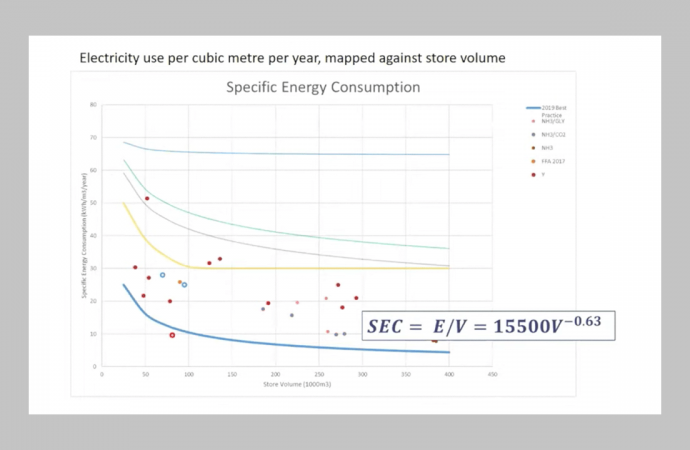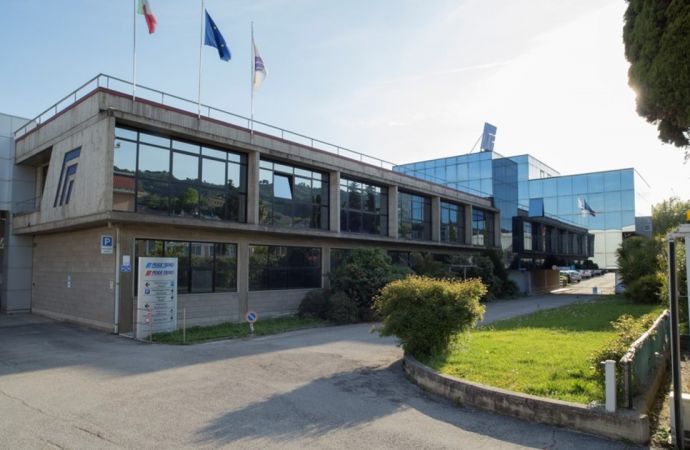Improving energy efficiency is ‘critical’ to the bottom line, with energy prices rising and becoming more volatile, according to the former IoR president.

Data from Andy Pearson's presentation at the IIR conference in Ohrid.
Cold storage facilities could save a lot by looking to energy-efficiency best practice, and not be content with an average energy performance, according to Andy Pearson, Group Managing Director at Star Refrigeration.
Pearson, a former president of the Institute of Refrigeration, and a well-regarded expert in industrial refrigeration, expressed this viewpoint at the International Institute of Refrigeration (IIR) conference on ammonia and CO2 refrigeration in Ohrid on September 16.
His company, Scotland-based Star Refrigeration, specializes in ammonia solutions, designing both energy-efficient refrigeration solutions, and heat pumps for district heating projects
“There is a massive variability between the average and the best practice,” Pearson explained, detailing data from a 2013 study by Professor Judith Evans of London Southbank University. “The range from best practice to worst performance is a factor of 10 to one with the average line, obviously, in the middle.”
Cold storage operators should therefore ask themselves a number of questions, Pearson said. How is my energy performance compared to last year? Compared to my competitors? Am I leading the way, or lagging behind? How is my performance compared to best practice in the industry?
This set of questions looks to the past, and once the operators have some answers, they should look to the future instead, to what they can improve, asking themselves, What can I do to make my performance better? Or, “’What do I need to do to keep my performance good?’ I can't just assume that having gotten good, it will stay that way,” Pearson continued. When looking into potential maintenance options, operators should also consider what effects these interventions would have on energy performance, Pearson stressed.
However, looking to current official best- practice targets may no longer be sufficient, according to Pearson. Inspired by Professor Evans’ study, Pearson embarked on his own investigation, and after several years he’s come to the conclusion that the official benchmarks in the U.K., where he’s from, are no longer good enough.
Pearson believes that new best-practice goals should be represented by an equation where the specific energy consumption (SEC) equals 15,500V-0.63, meaning that for a 100,000m3 cold store, the SEC should be about 10kWh/m3/year.
Managing costs
Reducing the energy consumption of refrigeration systems is not only about saving CO2 emissions, it’s also about saving money. The price of electricity has risen sharply over the last year, and in the U.K. it’s now twice what it was 10 years ago.
Prices are also much more volatile than they used to be, leading to uncertainty with owners and operators of refrigeration equipment not knowing what their costs will be.
The cost of electricity is typically about 5-20 percent of revenue for cold store operators, Pearson explained, adding that profits earned after loan repayments and depreciation could well be less than 20%. “So, improving energy efficiency is critical, because it will add directly to the business's bottom line profit,” he noted.
Another way of helping to control business costs is SEC prediction. “Basically, you only need four pieces of information to predict what the SEC will be for the year,” Pearson explained. “The four pieces are the volume of the cold store, the date that you took the first reading, the date that you took the last reading, and the total number of kilowatt hours recorded between those two dates.”
How accurate your predictions will be depends on how much time you have to gather data. “You have to strike a balance, you can have lots of data, but it takes a long time to gather if you're taking a reading every day.”
For the full SEC, a year's worth of data is needed. “Or you could predict based on just 10 days’ worth of data,” Pearson explained. “It would predict what the [SEC] value will be in 355 days time, and it's accurate to ±30%, of course, with the caveat, if nothing else changes.” Maintenance initiatives will naturally affect any predictions.
If you have a bit more time to gather data, then 90 days’ worth can give you an SEC prediction nine months ahead that is accurate to ±20%, according to Pearson.
In general, specific energy consumption, gives you valuable historic data — you can compare it with your performance last year, with your competitors, or with best practice. “But also it provides useful predictions of the effects that actions will have, or the inadvertent effects of known changes,” Pearson said.
For example, if a solenoid valve has been holding tight in the hot gas system but then starts leaking hot gas into the suction line, “you would expect to see the [SEC] go up,” he said. “Or if a float switch stopped operating, all of these things can be detected by monitoring the performance.”
The SEC system can be easily retrofitted to existing sites with a kilowatt-hours meter on the refrigeration system; this delivers a pulse input into a PLC, which collects the data and does “very simple calculations,” Pearson noted. “This helps to manage costs. It helps to give better control of maintenance activities, and it helps to inform investment decisions, in my opinion. Every plant should have one.”
Want to find out more, or have something to say about this story? Join the ATMO Connect network to meet and engage with like-minded stakeholders in the clean cooling and natural refrigerant arena.
Related stories




